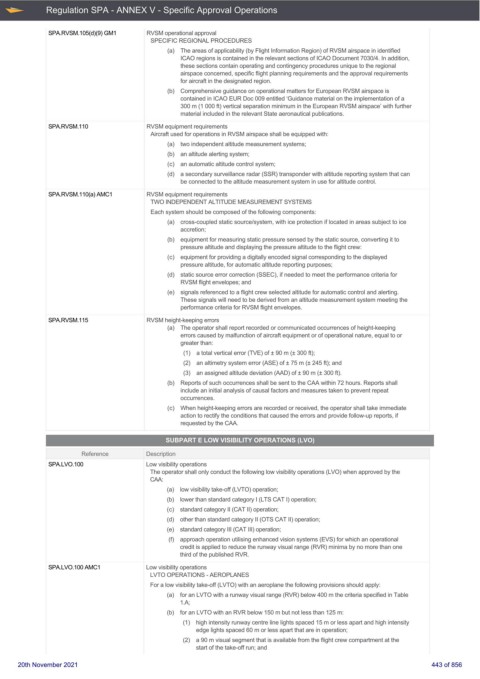Page 443 - UK Air Operations Regulations 201121
P. 443
~
~ Regulation SPA - ANNEX V - Specific Approval Operations Centrik
SPA.RVSM.105(d)(9) GM1 RVSM operational approval
SPECIFIC REGIONAL PROCEDURES
(a) The areas of applicability (by Flight Information Region) of RVSM airspace in identified
ICAO regions is contained in the relevant sections of ICAO Document 7030/4. In addition,
these sections contain operating and contingency procedures unique to the regional
airspace concerned, specific flight planning requirements and the approval requirements
for aircraft in the designated region.
(b) Comprehensive guidance on operational matters for European RVSM airspace is
contained in ICAO EUR Doc 009 entitled ‘Guidance material on the implementation of a
300 m (1 000 ft) vertical separation minimum in the European RVSM airspace’ with further
material included in the relevant State aeronautical publications.
SPA.RVSM.110 RVSM equipment requirements
Aircraft used for operations in RVSM airspace shall be equipped with:
(a) two independent altitude measurement systems;
(b) an altitude alerting system;
(c) an automatic altitude control system;
(d) a secondary surveillance radar (SSR) transponder with altitude reporting system that can
be connected to the altitude measurement system in use for altitude control.
SPA.RVSM.110(a) AMC1 RVSM equipment requirements
TWO INDEPENDENT ALTITUDE MEASUREMENT SYSTEMS
Each system should be composed of the following components:
(a) cross-coupled static source/system, with ice protection if located in areas subject to ice
accretion;
(b) equipment for measuring static pressure sensed by the static source, converting it to
pressure altitude and displaying the pressure altitude to the flight crew:
(c) equipment for providing a digitally encoded signal corresponding to the displayed
pressure altitude, for automatic altitude reporting purposes;
(d) static source error correction (SSEC), if needed to meet the performance criteria for
RVSM flight envelopes; and
(e) signals referenced to a flight crew selected altitude for automatic control and alerting.
These signals will need to be derived from an altitude measurement system meeting the
performance criteria for RVSM flight envelopes.
SPA.RVSM.115 RVSM height-keeping errors
(a) The operator shall report recorded or communicated occurrences of height-keeping
errors caused by malfunction of aircraft equipment or of operational nature, equal to or
greater than:
(1) a total vertical error (TVE) of ± 90 m (± 300 ft);
(2) an altimetry system error (ASE) of ± 75 m (± 245 ft); and
(3) an assigned altitude deviation (AAD) of ± 90 m (± 300 ft).
(b) Reports of such occurrences shall be sent to the CAA within 72 hours. Reports shall
include an initial analysis of causal factors and measures taken to prevent repeat
occurrences.
(c) When height-keeping errors are recorded or received, the operator shall take immediate
action to rectify the conditions that caused the errors and provide follow-up reports, if
requested by the CAA.
SUBPART E LOW VISIBILITY OPERATIONS (LVO)
Reference Description
SPA.LVO.100 Low visibility operations
The operator shall only conduct the following low visibility operations (LVO) when approved by the
CAA:
(a) low visibility take-off (LVTO) operation;
(b) lower than standard category I (LTS CAT I) operation;
(c) standard category II (CAT II) operation;
(d) other than standard category II (OTS CAT II) operation;
(e) standard category III (CAT III) operation;
(f) approach operation utilising enhanced vision systems (EVS) for which an operational
credit is applied to reduce the runway visual range (RVR) minima by no more than one
third of the published RVR.
SPA.LVO.100 AMC1 Low visibility operations
LVTO OPERATIONS - AEROPLANES
For a low visibility take-off (LVTO) with an aeroplane the following provisions should apply:
(a) for an LVTO with a runway visual range (RVR) below 400 m the criteria specified in Table
1.A;
(b) for an LVTO with an RVR below 150 m but not less than 125 m:
(1) high intensity runway centre line lights spaced 15 m or less apart and high intensity
edge lights spaced 60 m or less apart that are in operation;
(2) a 90 m visual segment that is available from the flight crew compartment at the
start of the take-off run; and
20th November 2021 443 of 856

